
Top 5 problem plants to get rid of while they're small
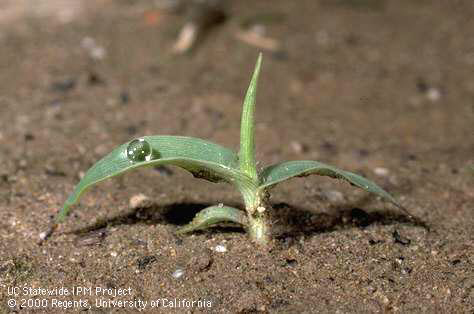
|
|
Crabgrass is easiest to eradicate when it's about this size. (Photo by Jack Kelly Clark, courtesy UCIPM)
|
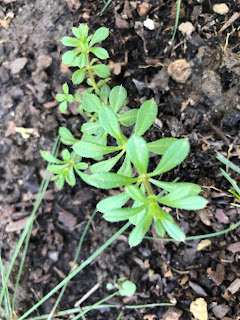
|
|
Bedstraw is the scourge of pet
owners. (Photo: Kathy Morrison)
|
The only time I envy gardeners living in snow country is late winter. They have white landscapes to look at. We have weeds.
The mild temperatures and just enough rain this time of year have weeds popping out all over. Some aren't even noticeable, tucked under larger plants or hiding for now under loose mulch. But they're there, and the sooner they're dealt with the better.
Why are weeds bad? Well, they suck up nutrients and water that other plants need. They're so well adapted that they spread like crazy. And they provide early food for that other scourge of the garden: "bad guy" insects. I was amazed to learn how many pests migrate from weeds to good plants during the spring.
So keep on top of the weeds and you keep on top of two problems. They're never completely eliminated, but at least they can be kept under control.
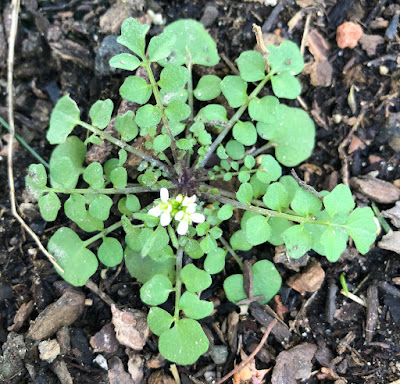
|
|
Little bittercress produces pods that can spread seeds
several feet when they pop open. (Photo: Kathy Morrison) |
Here are just five currently sprouting weeds that are crucial to hoe or dig out early:
1) Catchweed bedstraw ( Galium aparine ), also called cleavers and stickyweed, among others. Its sticky hairs catch on everything: T-shirts, socks, cat fur, dogs' tails, you name it. And it spreads that way. If allowed to grow large, it forms little burrs that are even harder to pull out of fur or socks.
2) Little bittercress ( Cardamine oligoosperma ), also known as shotweed or snapweed. I call this weed "pop-bead plant" because of the way the seeds explode out of their seed pod when you so much as brush past it. Dig it up before or while it's flowering to prevent it spreading far and wide.
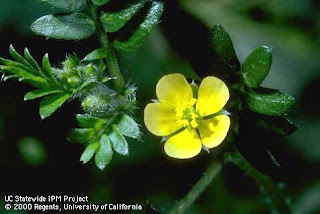
|
|
Puncturevine with flower. (Photo by Jack Kelly
Clark, courtesy UCIPM)
|
4) Crabgrasses ( Digitaria ssp.) The smooth-leaf one ( Digitaria ischaemum ) is most often found in turf, the one called large crabgrass ( Digitaria sanguinalis ) most often grows in gardens. Get 'em out while they're seedlings and you'll avoid having those big mats of soil-hogging grasses later.
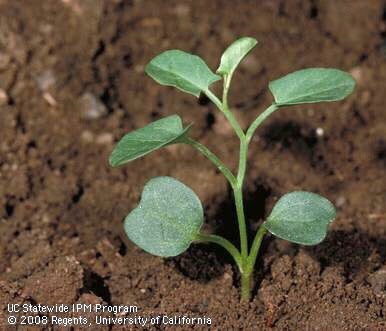
|
|
This is a bindweed seedling. Don't let it get much bigger. (Photo by Jack Kelly Clark, courtesy UCIPM) |
Of course, there are many, many more. To identify a weed, check the UC IPM Weed Gallery . Just don't let the (ahem) grass grow under your feet before getting those weeds gone.
Comments
0 comments have been posted.Sacramento Digs Gardening to your inbox.
Food in My Back Yard Series
May 6: Maintain soil moisture with mulch for garden success
April 29: What's (already) wrong with my tomato plants?
April 22: Should you stock up on fertilizer? (Yes!)
April 15: Grow culinary herbs in containers
April 8: When to plant summer vegetables
April 1: Don't be fooled by these garden myths
March 25: Fertilizer tips: How to 'feed' your vegetables for healthy growth
March 18: Time to give vegetable seedlings some more space
March 11: Ways to win the fight against weeds
March 4: Potatoes from the garden
Feb. 25: Plant a fruit tree now -- for later
Feb. 18: How to squeeze more food into less space
Feb. 11: When to plant? Consider staggering your transplants
Feb. 4: Starting in seed starting
Sites We Like
Garden Checklist for week of May 11
Make the most of the lower temperatures early in the week. We’ll be back in the 80s by Thursday.
* Plant, plant, plant! It’s prime planting season in the Sacramento area. Time to set out those tomato transplants along with peppers and eggplants. Pinch off any flowers on new transplants to make them concentrate on establishing roots instead of setting premature fruit.
* Direct-seed melons, cucumbers, summer squash, corn, radishes, pumpkins and annual herbs such as basil.
* Harvest cabbage, lettuce, peas and green onions.
* In the flower garden, direct-seed sunflowers, cosmos, salvia, zinnias, marigolds, celosia and asters. (You also can transplant seedlings for many of the same flowers.)
* Plant dahlia tubers.
* Transplant petunias, marigolds and perennial flowers such as astilbe, columbine, coneflowers, coreopsis, dahlias, rudbeckia and verbena.
* Keep an eye out for slugs, snails, earwigs and aphids that want to dine on tender new growth.
* Feed summer bloomers with a balanced fertilizer.
* For continued bloom, cut off spent flowers on roses as well as other flowering plants.
* Add mulch to the garden to maintain moisture. Mulch also cuts down on weeds. But don’t let it mound around the stems or trunks of trees or shrubs. Leave about a 6-inch-to-1-foot circle to avoid crown rot or other problems.
* Remember to weed! Pull those nasties before they set seed.
* Water early in the day and keep seedlings evenly moist.